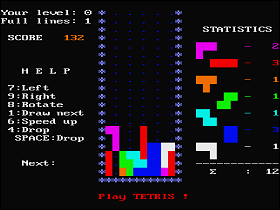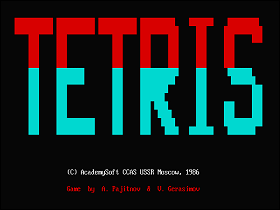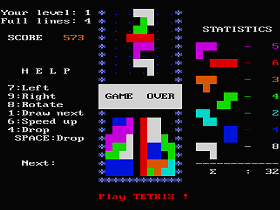 The Game: Various shapes consisting of four blocks each fall from the top of the screen, giving the player a short time to rotate, move (left or right only), and ultimately drop each piece into place. The goal is to put complementary shapes together, forming a solid line (or several solid lines) and leaving no gaps. Completed horizontal lines disappear from the screen, and the remaining pieces drop to the bottom. Bonus points are awarded for using the tallest piece – four blocks tall – to eliminate four lines at once. Allowing the shapes to pile up until they reach the top of the screen ends the game. (freeware, 1986)
The Game: Various shapes consisting of four blocks each fall from the top of the screen, giving the player a short time to rotate, move (left or right only), and ultimately drop each piece into place. The goal is to put complementary shapes together, forming a solid line (or several solid lines) and leaving no gaps. Completed horizontal lines disappear from the screen, and the remaining pieces drop to the bottom. Bonus points are awarded for using the tallest piece – four blocks tall – to eliminate four lines at once. Allowing the shapes to pile up until they reach the top of the screen ends the game. (freeware, 1986)
Memories: Created in 1984 while the programming trio of Alexey Pajitnov, Dmitry Pavlovsky and Vadim Gerasimov were working for the Soviet Academy of Sciences, Tetris was first programmed on a mainframe computer and its commercial potential was immediately recognized. Since it was designed and coded “on the clock” in Soviet government facilities, the government automatically had ownership of the program. The Soviet technology and software export bureau, Elektronorgtechnica (ELORG for short), had never dealt with a computer game, and dropped the ball. The programmers shrugged it off; Gerasimov’s MS-DOS PC port was released into the wild in 1986 with no expectation that anyone involved would ever profit from it, and that was that.
Compared to modern descendants of Tetris, this first PC edition seems simplistic, using text graphics to create its display. Gerasimov’s port is actually quite impressive, however, including automatic detection of the user’s graphics adapter (this being from the era when PC game publishers had to make games that would work for the standard monochrome XGA display or the color-capable CGA and EGA video cards now on the market). By modern standards, the keyboard control scheme is a bit less than intuitive, but it worked well enough at the time. Since sound cards were even more of a wild card than video cards, there’s no music to be heard.
 It was this port of the game that was handed around on floppy disks throughout eastern Europe until it managed to do the impossible and escape into western Europe. From there, Tetris spread like wildfire as a download via bulletin board systems, ultimately coming to the attention of UK software house Andromeda, which made tentative inquiries into licensing Tetris from ELORG – and then started claiming and selling “exclusive rights” to publishers like Spectrum Holobyte anyway, because surely there wasn’t any way to do business with a very minor organ of the Soviet government. And in those heady days in the eve of widespread internet use, surely it would be ages before ELORG or the game’s originators found out about it. (It’s telling that a final revision of Tetris – the widely circulated v3.12 – included an ELORG copyright notice in addition to the on-screen credits for Pajitnov and Gerasimov.)
It was this port of the game that was handed around on floppy disks throughout eastern Europe until it managed to do the impossible and escape into western Europe. From there, Tetris spread like wildfire as a download via bulletin board systems, ultimately coming to the attention of UK software house Andromeda, which made tentative inquiries into licensing Tetris from ELORG – and then started claiming and selling “exclusive rights” to publishers like Spectrum Holobyte anyway, because surely there wasn’t any way to do business with a very minor organ of the Soviet government. And in those heady days in the eve of widespread internet use, surely it would be ages before ELORG or the game’s originators found out about it. (It’s telling that a final revision of Tetris – the widely circulated v3.12 – included an ELORG copyright notice in addition to the on-screen credits for Pajitnov and Gerasimov.)
It was also at about this time that Henk Rogers took notice of the game and ventured into the USSR to find out who really held rights to the game. Upon learning that real money was being made with his creation, Pajitnov – who had been brewing up game ideas with Gerasimov and Pavlovsky – decided to focus exclusively on Tetris, creating enough strife within the small team to break it up. Rogers secured the console rights to Tetris, while Andromeda finally paid for the rights that it had been selling in the western world, including an arcade version made by Sega and a cartridge version for the NES developed by Atari‘s Tengen division. But Rogers wasn’t after the computer rights to the game; he wound up with the exclusive license for console and handheld versions of Tetris, which he took to Nintendo. At a very late stage in  pre-release planning for its new Game Boy handheld, Nintendo did an about-face, making Tetris the game that would be included with the Game Boy rather than yet another Mario game.
pre-release planning for its new Game Boy handheld, Nintendo did an about-face, making Tetris the game that would be included with the Game Boy rather than yet another Mario game.
With the prospects for real success – and capitalism! – tempting him, Alexey Pajitnov emigrated to the United States in 1991, forming The Tetris Company with Henk Rogers in 1996 and beginning to claw back the exclusive rights to his creation from the post-communist remnants of ELORG and from everyone else who had been claiming those rights for the past decade. This also included a controversial practice of sending cease-and-desist notices to every developer of unauthorized knockoffs of Tetris the company could locate, something to which ELORG would never have devoted the time on Pajitnov’s behalf. Perhaps unsurprisingly, Alexey Pajitnov is living very comfortably in the United States, with Tetris licensing on every imaginable platform (mobile phones and smartphones have proven to be a particularly lucrative market) providing a steady enough stream of income to base The Tetris Company in Hawaii. Gerasimov also emigrated, finishing a degree at MIT and going to work for Google, while Pavlovsky moved to England; both Pavlovsky and Gerasimov were dismayed as, over time, their names vanished from the official accounts of the game’s birth; neither of them ever saw a penny of profit from the success of Tetris.
 It seems doubtful that the three designers and programmers of Tetris, looking for games simple enough to play without overwhelming hulking Soviet mainframes, ever imagined the fates that awaited them while porting Tetris to the IBM PC (which was also not exactly designed with video games in mind). Once Gerasimov’s PC edition leaked into the western world, however, this was one tiny corner of the cold war that the Soviets – at least three of them – unquestionably won, if for no other reason than the severe damage to western business productivity that Tetris would go on to cause.
It seems doubtful that the three designers and programmers of Tetris, looking for games simple enough to play without overwhelming hulking Soviet mainframes, ever imagined the fates that awaited them while porting Tetris to the IBM PC (which was also not exactly designed with video games in mind). Once Gerasimov’s PC edition leaked into the western world, however, this was one tiny corner of the cold war that the Soviets – at least three of them – unquestionably won, if for no other reason than the severe damage to western business productivity that Tetris would go on to cause.